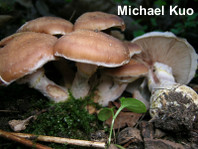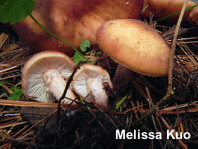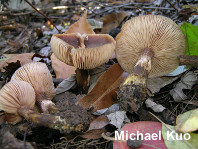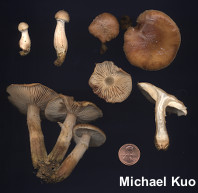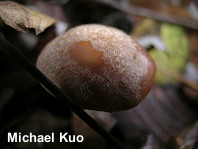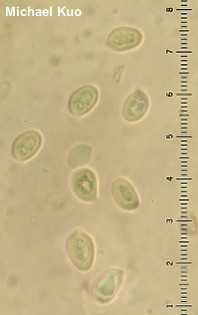| Major Groups > Gilled Mushrooms > Pale-Spored > Armillaria > Armillaria gallica |

|
Armillaria gallica [ Basidiomycota > Agaricales > Physalaciaceae > Armillaria . . . ] by Michael Kuo This honey mushroom is widely distributed east of the Rocky Mountains, and is typically found on the ground or near the bases of hardwoods. It is smaller, on average, than Armillaria mellea, and its ring tends to be cobwebby or ephemeral, almost like a cortina. It is more apt to grow alone or in loose groups than in densely packed clusters that cause the stem bases to be pointed. In fact, the stem base of Armillaria gallica is often a bit swollen, exhibiting, in the words of Armillaria expert Tom Volk, a "bulbicitiness" not found in most other honey mushrooms. Although it can be found in late summer and early fall, Armillaria gallica is usually a late-fruiting species, appearing in the colder weather of late fall and early winter—or even in the depths of winter, during warm spells. In urban areas it is not uncommon in places where hardwood trees were removed several years beforehand, popping up as a "lawn mushroom" without any immediately obvious relationship to rotting wood—though the tree's decaying root system is the actual substrate for the fungus. Armillaria calvescens is similar to Armillaria gallica—so similar that the two species cannot reliably be separated without attempting to "mate" them in a laboratory or sequencing their DNA (have fun). The range of Armillaria calvescens is more northerly, however; it appears to be rare or absent south of a line roughly below the southern edge of the Great Lakes. A 2011 study (Kim & Klopfenstein) found only Armillaria gallica present in a Nebraska nature preserve; Armillaria calvescens was absent. Armillaria lutea and Armillaria bulbosa are synonyms. Description: Ecology: "[U]sually an innocuous saprophyte, living on organic matter in the soil and not harming trees to any great extent" (Volk & Burdsall, 1993); growing on the wood of hardwoods and occasionally on conifer wood; appearing alone, gregariously, or in loose clusters; often appearing terrestrial (but actually attached to roots)—but sometimes fruiting from the bases of trees and stumps; late summer, fall, and winter; widely distributed east of the Rocky Mountains. The illustrated and described collections are from Illinois, Wisconsin, and Michigan. Cap: 3–10 cm; convex, becoming broadly convex or nearly flat; dry or sticky; bald underneath scattered, tiny, yellowish to brownish scales and fibrils (often concentrated over the center); pinkish brown to tan or, occasionally, yellowish; fading markedly as it dries out; the margin sometimes featuring whitish to yellowish partial veil material when young, becoming lined with age. Gills: Running down the stem or nearly so; close; short-gills frequent; whitish, discoloring pinkish to brownish. Stem: 4–7 cm long; 1–3 cm thick; usually club-shaped, with a swollen base; finely lined near the apex; with a yellow ring zone or, occasionally, with a flimsy white ring that features a yellow edge; whitish to brownish when fresh, becoming dark watery brownish to olive gray from the base upward; base sometimes staining yellow; often attached to black rhizomorphs. Flesh: Whitish; unchanging when sliced. Odor and Taste: Odor not distinctive; taste not distinctive, or slightly bitter. Chemical Reactions: KOH on cap surface yellowish to golden, or negative. Spore Print: White. Microscopic Features: Spores 7–10 x 4–6 µm; ellipsoid with a fairly prominent apiculus; smooth; hyaline to yellowish in KOH; inamyloid. Basidia 4-sterigmate; basally clamped. Cheilocystidia 15–40 x 2.5–5 µm; cylindric-flexuous to somewhat irregular or contorted; smooth; thin-walled; hyaline in KOH. Pleurocystidia not found. Pileipellis a cutis or ixocutis with areas of upright elements; cutis elements 5–15 µm wide, smooth, hyaline to brownish, with terminal cells cylindric with subclavate to slightly narrowed apices; upright elements 5–15 µm wide, smooth or finely roughened, brownish in KOH, often slightly constricted at septa, with terminal cells cylindric with rounded or slightly narrowed apices. REFERENCES: Marxmüller & Romagnesi, 1987. (Moser, 1983; Berube & Dessureault, 1988; Volk & Burdsall, 1995; Volk, 2003; Binion et al., 2008; Vesterholt, 2008; Kim & Klopfenstein, 2011; Buczacki, 2012; Kuo & Methven, 2014.) Herb. Kuo 09210401, 11020401, 09150721, 11121102. This site contains no information about the edibility or toxicity of mushrooms. |
© MushroomExpert.Com |
|
Cite this page as: Kuo, M. (2017, January). Armillaria gallica. Retrieved from the MushroomExpert.Com Web site: http://www.mushroomexpert.com/armillaria_gallica.html |
